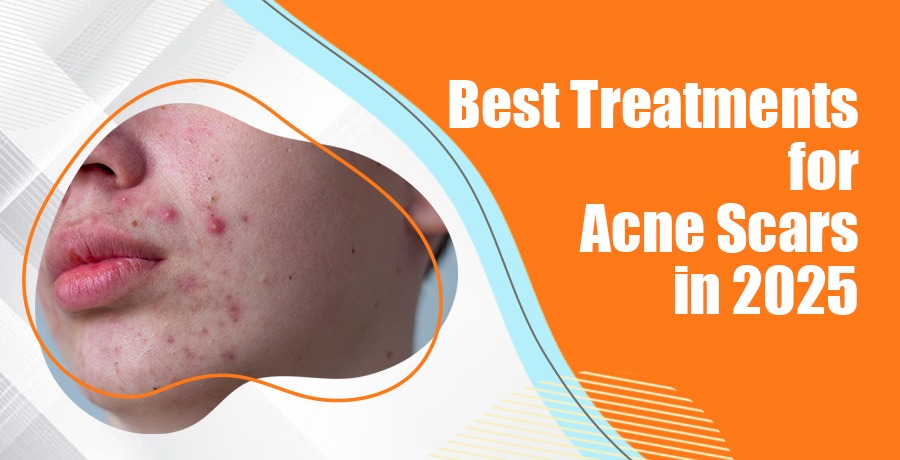
Acne can be seen like a war and the scars it leaves can feel like the aftermath of a conflict. You are not alone in that feeling, research says that a whopping 95% of people who experience acne will leave with some form of scarring. Acne scarring can take the form of colors varying from faint discoloration to deep pits. The scarring that acne can leave behind can be a frustrating and constant blemish of a former pesky break-out.
The good news? The dermatology world is amplifying with new technologies and procedures every year, and I can confidently tell you that in 2025, the treatment options for any pimple scar are better than they have ever been. The most important piece of information to mention though is that we need to first treat the source. The absolute best way to avoid scarring is to have an effective pustules treatment plan to manage your active acne. Once your skin is free-and-clear, you can start focusing on the marks that were left behind.
This guide will help you understand the types of scars you may have, and the most powerful acne scar treatment options available today to aspire towards the skin you deserve from break-outs, post-acne.
First, Know Your Scars: A Simple Guide
Not all acne scars are the same, and the right treatment depends entirely on the type of scar you have. They generally fall into two main categories:
- Atrophic (Depressed) Scars: These are the most common type, caused when the healing process doesn't produce enough collagen, leaving an indentation in the skin.
- Ice Pick Scars: Deep, narrow pits that look like the skin was punctured with a tiny ice pick.
- Boxcar Scars: Wider, box-like depressions with sharp, defined edges.
- Rolling Scars: Broad depressions with sloping, wave-like edges that make the skin's surface look uneven.
- Hypertrophic & Keloid (Raised) Scars: These are less common on the face and occur when the body produces too much collagen during healing. The scar tissue rises above the skin's surface.
The 2025 Treatment Toolkit: Your Path to Smoother Skin
Once you've identified your scar types, you can explore the best solutions. The most effective plans often involve a combination of the following in-office procedures.
Laser Resurfacing: The High-Tech Solution
Laser resurfacing still sets the standard for treatment of acne scars. It is particularly effective for texture issues, but can also improve pigmentary issues. Laser resurfacing uses focused beams of light to treat acne scars by either removing the damaged outer layer of skin (ablative) or heating the deeper layers of skin (non-ablative). Both types of lasers obtain results by inducing a powerful healing response that clears away old, disorganized collagen and promotes the formation of new, smooth, healthy skin.
- Best For: Boxcar and rolling scars or sometimes shallow ice pick scars.
- What to Expect: Different intensities are possible with laser resurfacing. Ablative lasers (like CO2) can produce dramatic results, but often come with downtime. Non-ablative lasers come with fewer side effects and less downtime, but will likely require a greater number of sessions to achieve overall results.
Microneedling (Collagen Induction Therapy): Rebuilding from Within
Think of microneedling as similar to aerating a lawn to stimulate new growth. Using a specialized device with small, sterile needles, microneedling creates thousands of little micro-injuries within the epidermis (the outer layer of skin). This "controlled injury" causes a surge in your own skin's healing response, which floods the area with new collagen and elastin to fill in and soften depressed scars.
- Best for: Rolling scars and shallow boxcar scars.
- The 2025 upgrade: Microneedling with PRP (platelet-rich plasma) or Radiofrequency(RF) Microneedling. Microneedling with PRP harnesses the power of your own blood product to turbo charge the healing response. Microneedling with RF adds heat through the tips of the needles, inducing even more dramatic collagen stimulation and tightening of the skin.
Chemical Peels: A Fresh Start for Your Skin
Chemical peels use an acid-based solution to exfoliate the upper layers of the skin, assisting in new and healthier cell turnover. In the process, chemical peels also remove other damaged skin, improving the appearance of shallow scars and discoloration. Chemical peels are divided into three levels of strength:
-
Superficial Peels (AHA, Salicylic Acid)- Effective treatment of post-inflammatory hyperpigmentation (the dark marks left behind after a pimple).
- Medium-to-Deep Peels (TCA, Phenol)- Effects of deeper penetration have more potential to improve major texture change through shallow atrophic scars.
Dermal Fillers: An Instant Lift
Dermal fillers provide an instant fix for some depressed scars. A dermatologist injects a substance (usually hyaluronic acid) directly under a pimple scar to raise the depression instantly so that it is more level with the surrounding skin.
- Best for: Rolling and some boxcar scars.
- Take note: The results are great, but temporary, usually for 6 - 18 months.
Subcision: Releasing Deep Scars
Sometimes, a rolling scar is physically anchored down by fibrous bands of tissue under the skin. Subcision is a minor procedure where a dermatologist uses a special needle to carefully cut these tethers, releasing the scar and allowing the skin to rise back to a smoother level. It's often combined with other treatments like fillers or microneedling for the best results.
Prevention and At-Home Support
While professional treatments are most effective, what you do at home matters immensely.
- DO NOT Pick: Squeezing or picking at pimples dramatically increases inflammation and the risk of scarring.
- Treat Acne Early: As mentioned, a solid pustules treatment plan from the start is the best prevention.
- Use Sunscreen Religiously: Sun exposure can darken scars and make them much more noticeable. A daily broad-spectrum SPF 30+ is non-negotiable.
- Incorporate Key Ingredients: Topical retinoids (like tretinoin), Vitamin C, and exfoliating acids (like glycolic and salicylic acid) can help speed up cell turnover and fade discoloration over time.
Your Next Step with Dr. Anup Dhir
While it's empowering to know your options, the most crucial step is a personalized consultation with an expert. If you are ready to create a tailored plan for your skin, renowned cosmetic surgeon Dr. Anup Dhir can accurately diagnose your scar types and recommend a combination of the most advanced treatments to achieve your goals.
With the advanced tools available in 2025, achieving smoother skin is a realistic goal. Contact Dr. Anup Dhir today to schedule your consultation and take the first step towards leaving your acne scars in the past.

